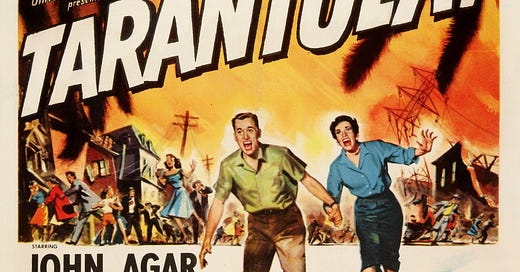For the last few years, I have used October to give myself a viewing assignment: a different horror film each day. Now that I have escaped the real life horror of New Zealand’s public service, I intend to write a piece inspired by each film.
My thirty-first and final film is Jack Arnold’s Tarantula (1955).
One of my favourite depictions of the horror of the nuclear age is Part 8 of David Lynch’s third season of Twin Peaks. I was thrilled to be able to see The Spectre Collective perform a live score for this episode earlier in the year. Taking a leave of absence from the show’s regular Pacific Northwest setting, it travels back in time to New Mexico in 1945 and the detonation of the first atomic bomb. Lynch posits that much of the horror of the previous two-and-a-half seasons entered the world at this very moment.
There’s something so compelling about the arid Southwest United States as the setting for horror. From the stories of extraterrestrials surrounding Roswell New Mexico and Area 51 Nevada to the deformed family of cannibals at the centre of The Hills Have Eyes, people love the idea of something lurking in the desert. Even if you don’t take it as far as Lynch does, it’s hard not to agree with Oppenheimer that something evil did enter the world during the Trinity Test. The giant spider at the centre of my final horror film of the month belongs to this same lineage.

Jack Arnold directed Tarantula two years before The Incredible Shrinking Man (also featuring a climactic fight with a tarantula). Mad scientist Dr. Gerald Deemer unwittingly unleashes the spider on the town of Desert Rock, Arizona while using radioactive elements to try and solve world hunger. Physician Dr. Matt Hastings teams up with scientist Steve Clayton (a woman!) to try and stop the monster.
Among the horror of the `50s, there were a handful ‘American kaiju’ films. I’ve already written about The Beast from 20,000 Fathoms and my personal favourite is 1954’s Them! which makes a direct link between its giant ants and Trinity. But even if the military industrial complex brought a great evil into the world, in all these films, those brave Cold Warriors are the only ones who can stop the monster. In Tarantula, the US Air Force burns the spider to a crisp with napalm.


The effects on display in the film are some of my favourite of the era. There have been quite a few tarantulas across the films I’ve watched over the last 31 days (Roger Corman would often throw one into a scene for a cheap scare) but this is the best. In real life these spiders are sweethearts, like mice with more legs, but the use of miniatures and the desert location make it genuinely threatening. I was pleasantly surprised by the high-quality of all five of the `50s sci-fi films I watched and would recommend all of them but this might be the purest distillation of what can make them effective.

Thanks so much to everyone who’s been reading along during the month! I’ve mainly been doing these horror recaps in order to get myself into a rhythm with my writing but I think I’ve found ways to weave in my own political reckons. During November though, I’ll start producing work with a wider appeal. Please let me know what you’re interested in.




